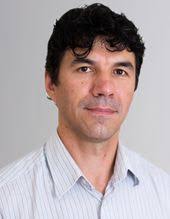Catalysis on plasmonic metal nanoparticles: opportunities for highly selective chemical conversion
Suljo Linic
Department of Chemical Engineering, University of Michigan
3:30pm - April 5, 2018 - ELTC 1-001
Abstract:
Metal nanoparticles are used as commercial catalysts for many chemical reactions, including ammonia synthesis, hydrocarbon reforming, oxidation and hydrogenation reactions. In commercial systems, these reactions are triggered by the thermal heating of catalyst nanoparticles. This process excites the phonon modes of the nanoparticles, which couple with the reaction coordinate (for example, vibrational modes of the reacting adsorbates). This coupling results in the evolution of the adsorbate from the reactant to the product state on the ground-state potential energy surface. These reactions usually require relatively high temperatures, and the distribution of the products is governed by the ground-state free-energy landscape. They offer limited opportunities to tune the product selectivity.
We recently made an important breakthrough by showing that relatively small plasmonic metal nanoparticles, illuminated with visible light, can activate chemical reactions on their surfaces in an alternative mechanism. We showed that these chemical transformations are driven by the energetic charge carriers that are formed on the surface of the nanostructures upon their interaction with resonant light and transferred from plasmonic nanoparticles to the reacting adsorbates. This has led to an entirely new field of chemical conversion, often referred to as plasmonic catalysis. Unlike in the case of phonon-driven reactions, it is in principle possible to change (and improve, through targeted design of nanostructures) the product selectivity compared with phonon-driven thermal reactions.
I will discuss: (i) the physical features of plasmonic nanoparticles that make them ideal for the charge transfer mediated reactions, (ii) the mechanism of charge-carrier driven chemical transformations on metals, (iii) the mechanisms behind the plasmon-induced charge injection processes, (iv) the approaches to engineer these nanostructures so that they can support specific chemical transformations to make value-added products with high selectivity and at lower temperatures.
Biography:

Suljo Linic was born in northwestern Bosnia and Herzegovina. He completed his high school education in Bosnia. He was displaced from Bosnia during the Bosnian war of the 1990s. He moved to the USA in 1994 after he was awarded a faculty scholarship from West Chester University (West Chester, PA). He completed his BS degree in Physics with minors in Mathematics and Chemistry at West Chester University (PA) in the spring of 1998. In the fall of 1998, Suljo moved to the University of Delaware to study surface chemistry and catalysis under Prof. Mark Barteau in the Center for Catalytic Science and Technology. There he earned MS and PhD degrees in chemical engineering in 1999 and 2003, respectively. Early in 2003, Suljo was offered a faculty position at the Department of Chemical Engineering at the University of Michigan in Ann Arbor. Before moving to Ann Arbor to start his independent faculty career, Suljo relocated to Berlin (Germany) to work with Prof. Mathias Scheffler on ab initio simulations of chemical transformations on graphene and carbon nanotubes as a Max Planck postdoctoral fellow at the Fritz Haber Institute. Suljo started as an Assistant Professor at University of Michigan in September of 2004. He was promoted to Associate Professor in September 2010. In the September of 2014, he was promoted to Professor and was appointed the Class of 1938 Faculty Fellow. Since 2010, Suljo has also been leading Energy Systems Engineering program at Michigan. Since 2015 Suljo is also a Hans Fischer Fellows at chemistry department of Technical University in Munich.
Suljo directs a research program focused primarily on heterogeneous catalysis and surface chemistry in areas ranging from selective oxidation, to hydrocarbon reforming, to electrocatalysis and photocatalysis. His research has been recognized through multiple awards including the 2016 Parravano award by the Michigan Catalysis Society, the 2014 ACS Catalysis Lectureship awarded by the journal ACS Catalysis and the ACS Catalysis Division, the 2011 Nanoscale Science and Engineering Forum Young Investigator Award, awarded by American Institute of Chemical Engineers, the 2009 ACS Unilever Award awarded by the Colloid and Surface Chemistry Division of ACS, the 2009 Camille Dreyfus Teacher-Scholar Award awarded by the Dreyfus Foundation, the 2008 DuPont Young Professor Award, and a 2006 NSF CAREER Award. Since 2015, Suljo has served as an associate editor of ACS Catalysis, a multi-disciplinary catalysis journal published by the American Chemical Society.